NATIONAL PARK SERVICE
Park Structures and Facilities
|

|
TRAIL STEPS
DESIRABLE AS STEPS ARE at many points in many trails,
by no means are they ever to be created for their own sake. It is
perhaps not generally sensed that if as much study were given to trail
planning as to modern road planning, lesser grades and consequently
fewer trail steps would result. In any case, only an unavoidably sharp
grade not readily negotiable as such, with no reasonable alternative of
an easier grade, will justify resorting to steps at all.
That the first purpose in providing steps along steep
trails is to facilitate walking is undeniable. Less obvious perhaps, but
not less important is another consideration. This is the safeguarding
of the aspect of naturalness in every detail of the construction of
trail steps.
Trail steps, to justify their presence in natural
areas, must facilitate walking to just such extent as will not corrupt
this natural quality. Conversely, trail steps must strive to emulate
nature only to a degree that will not make them extremely hazardous in
use. Either approach should result in approximately the same
satisfying compromise. The facilitation of walking along trails in
natural areas can hardly lay claim to all the considerations of
uniformity of rise and tread, and relationship between these, that may
be demanded of steps in almost every other location. It is not
unreasonable to assume that nature trails are created for the use of
hardy hikers entitled to acquaintance with nature unarrayed with safety
treads and handrails.
There are admittedly within most parks, limited areas
of concentration used by persons of all ages and of differing capacities
for physical activity. Obviously, for steps within such areas the claim
of easy and safe walking should rank in importance above the claim of
complete naturalness, and the time-proved principles and practices in
satisfaction of the former are applicable at such locations in greater
degree. But for the trails into areas of less intensive use, and with
these we are here principally concerned, steps will not demand of the
natural setting unreasonable and discordant compromise in adaptation to
human use.
In park reservations where there are rock
outcroppings, and especially where these are of ledge rock, the very
background goes far to contribute naturalness to man-made trail steps.
Yet even with the most sympathetic collaboration of nature, the
execution of steps requires considerable skill for wholly satisfying
results. The characteristics of the stratifications of ledge rock can
often be utilized or reproduced in the creation of steps to such results
that they are almost without trace of the artificial. Where rock
outcroppings do not exist to provide liaison with the landscape, the
naturalizing of rock steps requires a sculptor's skill and sense of
form, if an anomalous creation is to be avoided. Even here the effort
should be to give the constructed steps the appearance of natural
ledges. To create such aspect it is most important that the width of
treads vary. Rocks forming cheeks at either side of the steps should
vary in horizontal alignment, as well as in height, and should be tied
and blended into the setting by being occasionally and irregularly
extended some distance into the vegetation to either side. No mortar
should be evident,—greater naturalness will result from dry
construction. Width of treads and height of risers will be governed by
the natural slope. Treads should be as wide as possible and risers,
except under unusual conditions, should not exceed six inches in height.
Rock ledges may naturally exist in the trail where the grade is not so
steep as actually to require step forms, yet because the rock is
present, steps with risers lower and treads deeper than usual become a
logical treatment.
For trails where rock is not an indicated
characteristic of the environment, and where the attempt to naturalize it
will evidence much of struggle, the steep grades of trails can be made
more negotiable by forming risers of timbers, and providing treads by
filling in with gravel or earth. There are various techniques in the
fashioning of the timbers, and in methods of anchorage, which
achieve different degrees of practical and artistic attainment, as the
illustrations suggest. Trail steps of this construction cannot be termed
naturalistic with accuracy, but it should be possible to claim them
harmonious with environment and not hazardous in use. As with all use
of logs in park construction, the timber risers should be stripped of
bark, not only because this will in time naturally occur, but because in
the certain process of loosening, bark will constantly be a source both
of hazard and of litter. Sometimes timber risers are roughly squared or
carefully hand hewn. Such, while not "going native" to the extent of
timbers left in the round, probably boast a higher safety rating in the
sprain and fracture statistics. Timber risers should be staked in place
to insure against loosening and shift in position. Exposed stakes
should be driven well below the tread surfaces so there is no projection
in which a heel might catch. Better still are methods that admit of
anchorage by invisible stakes.
There are numerous examples of unusual methods or
solutions in provision of trail steps. Often the abruptness of grade
makes necessary a veritable stairway steeper than the easy rise and
tread we know to be ideal. Often a ladder must be built when the grade
is precipitous. In a land of giant trees, one that has fallen across a
gorge or ravine will provide a picturesque foot bridge which, when out
of level beyond a certain degree, can be notched to form steps and
equipped with rustic handrail.
A handrail is often a necessary safeguard in
connection with trail steps narrowly confined between a rising cliff on the
one hand and a precipitous drop on the other. It is vital that a
handrail be thoroughly substantial in character and in fact, inviting
as it does the reliance of adventurous recreation seekers. Better no
handrail in any location, than one that cannot be trusted both in use
and abuse. Far too many handrails are probably structurally adequate and
safe, but are an offense by reason of flimsy appearance.
Trail Steps of Logs
Here grouped for comparative study are shown logs in
provision of steps in trails. The practical and aesthetic merits of
square timbers and logs in the round, contrived to this purpose, are
here on parade. The picturesqueness of the several examples illustrated
is apparent at a glance.
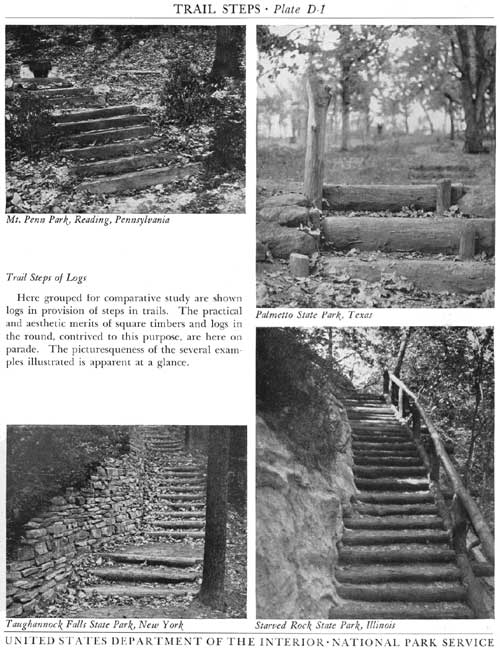
|
|
Plate D-1 (click on image for a PDF version)
|
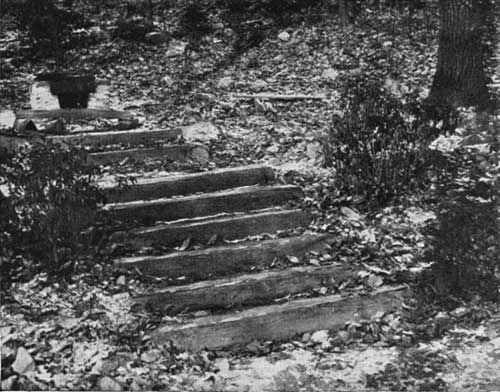
|
|
Mt. Penn Park, Reading, Pennsylvania
|

|
|
Palmetto State Park, Texas
|
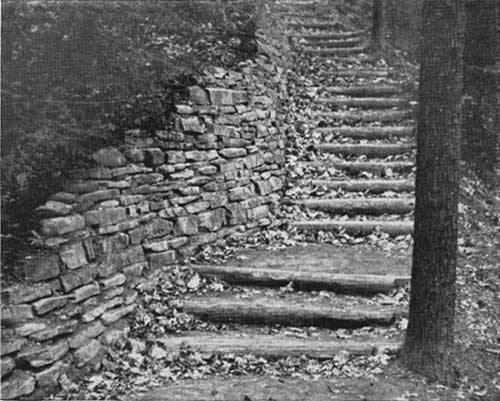
|
|
Taugnannock Falls State Park, New York
|
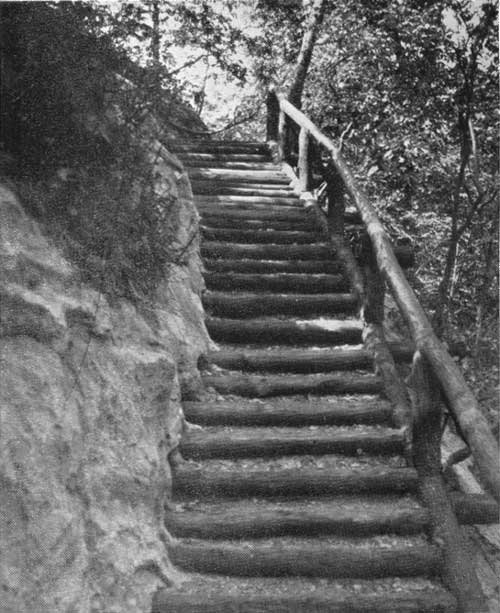
|
|
Starved Rock State Park, Illinois
|
Variety in Grade Negotiation
Above are log risers and treads paved with random
flagging; below are simple trail steps of stone well naturalized by
means of skillful planting of the trailside.
To the left are illustrated means for negotiating
grades too steep for an easy rise and tread. A trail ladder requires
careful maintenance, and is a hazard in use. The inclined log serving
as foot trail bridge, although something of a "stunt," surely is
permissible in parks where huge trees are present. Its picturesqueness,
as well as its practicability, recommend it.
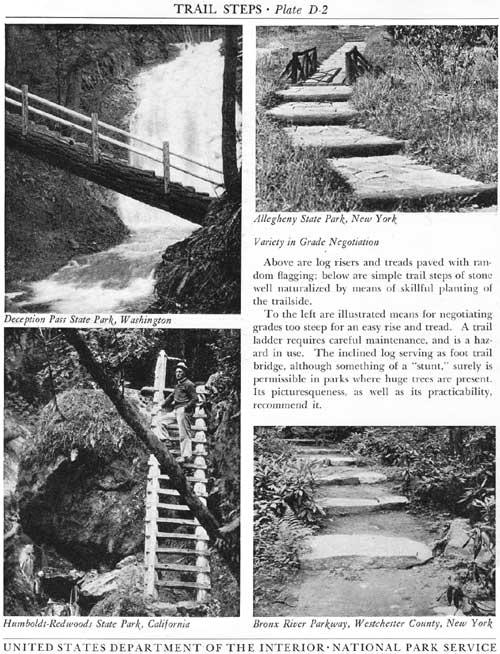
|
|
Plate D-2 (click on image for a PDF version)
|
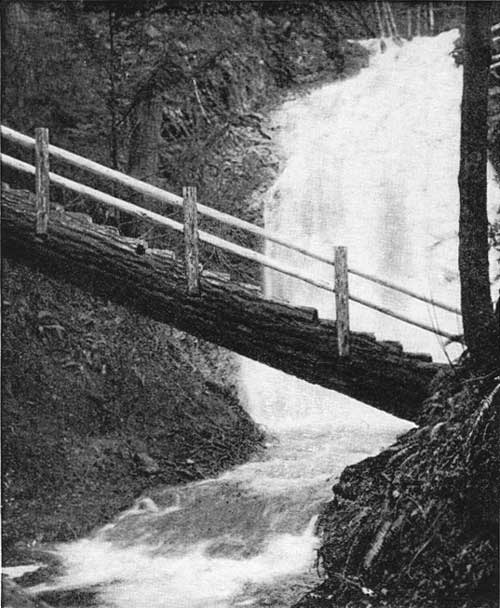
|
|
Deception Pass State Park, Washington
|
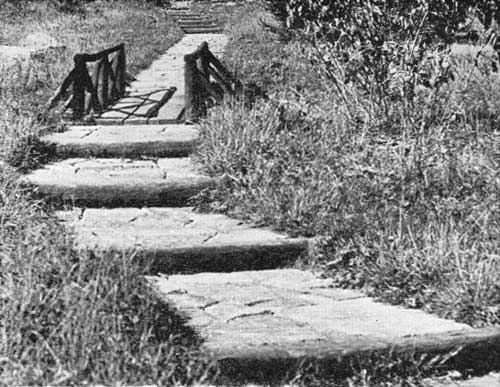
|
|
Allegheny State Park, New York
|
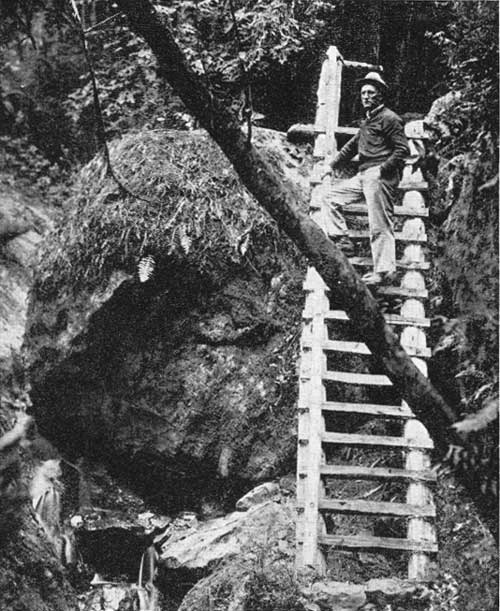
|
|
Humboldt-Redwoods State Park, California
|
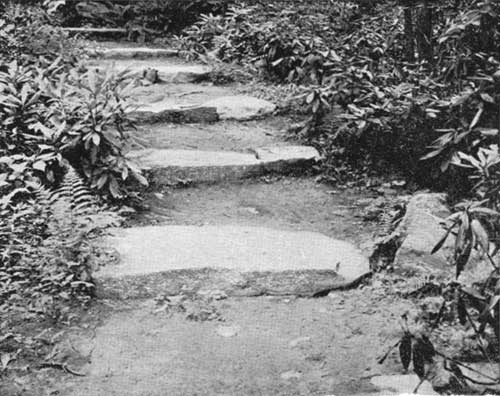
|
|
Bronx River Parkway, Westchester County, New York
|
Trail Step Sculpturing
The surrounding illustrations prove the truth of the
assertion that the naturalizing of artificial trail steps of rock
requires a sculptor's sense of form. Here is ample evidence of
accomplishment that must have been so approached. The blending to
trailside, the variations in height of riser and depth of tread, the
sparing use of mortar, are important factors recommended for observation
and mental note.
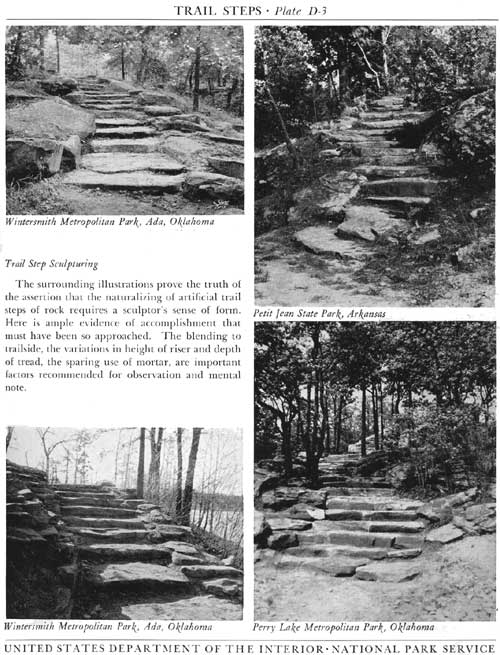
|
|
Plate D-3 (click on image for a PDF version)
|
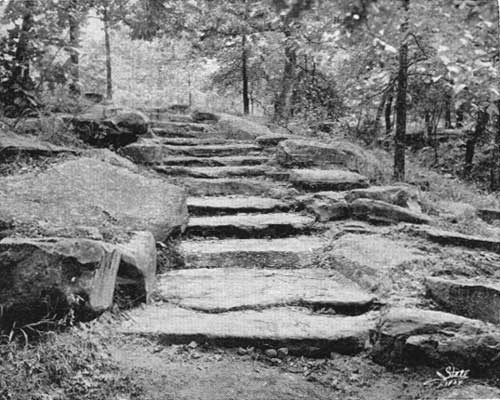
|
|
Wintersmith Metropolitan Park, Ada, Oklahoma
|
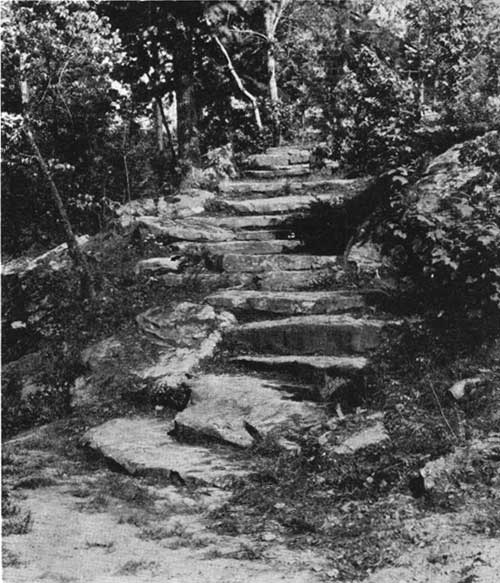
|
|
Petit Jean State Park, Arkansas
|
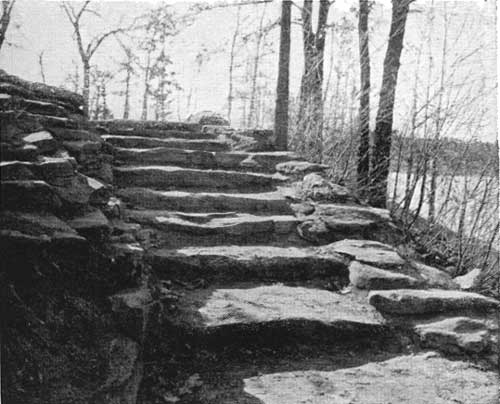
|
|
Wintersmith Metropolitan Park, Ada, Oklahoma
|
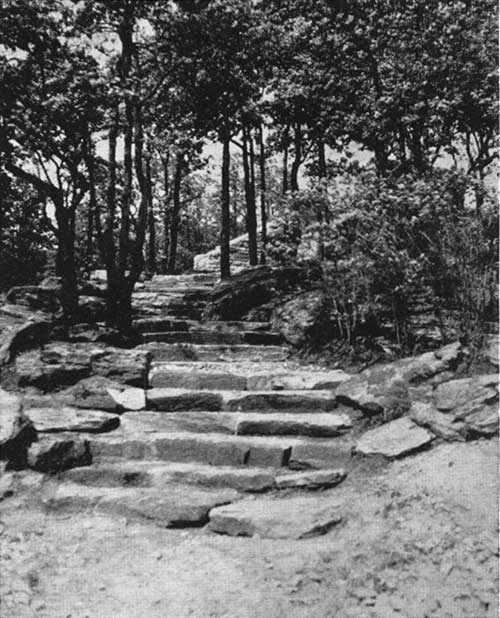
|
|
Perry Lake Metropolitan Park, Oklahoma
|
Trail Stairways of Stone
In all the subjects framing this comment will be
sensed a departure from the imitation of nature in the direction of the
more frankly man-made. Steeper grades are the problem here encountered,
and more uniform steps the solution very properly arrived at.
Notwithstanding this serving of practical requirement, the results are
certainly not unpleasantly conventional and not too mathematically
exact.

|
|
Plate D-4 (click on image for a PDF version)
|
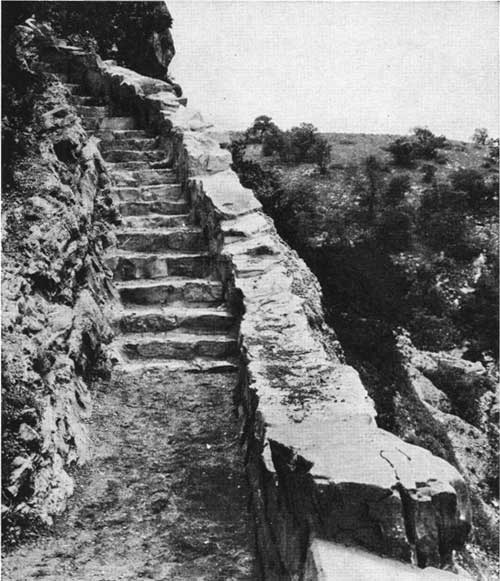
|
|
Turner Falls State Park, Oklahoma
|
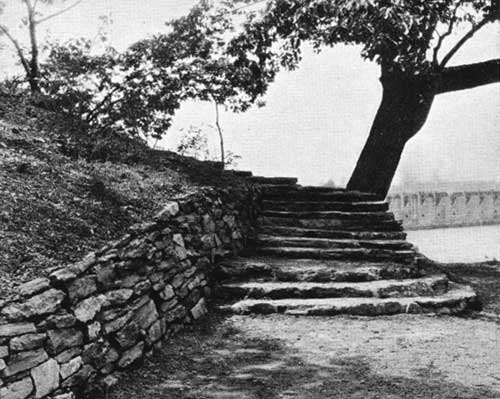
|
|
Wheeler Dam Reservation, Tennessee Valley Authority
|
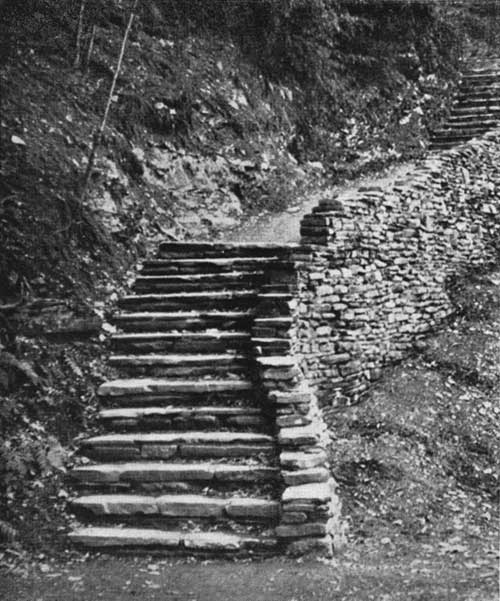
|
|
Taughannock Falls State Park, New York
|
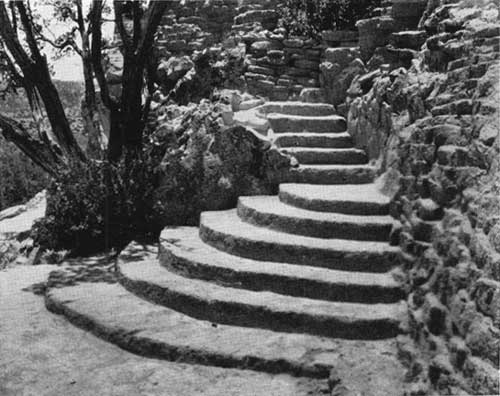
|
|
Palo Duro State Park, Texas
|
park_structures_facilities/secd.htm
Last Updated: 5-Dec-2011
|




















